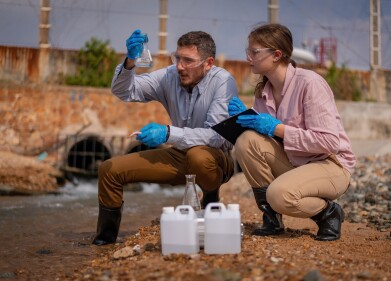Water/wastewater
How is Japan Handling Radioactivity in Fukushima Waters?
Jun 02 2023
The Fukushima Daiichi nuclear power station in Japan, operated by Tokyo Electric Power Company Holdings (Tepco), has become synonymous with the massive 2011 disaster that changed the nation's course. Today, more than a decade later, new challenges loom over the horizon. The most significant among these is a severely damaged support structure inside the reactor that bore the brunt of the disaster. The authorities are grappling with this emergent issue that demands immediate attention and comprehensive risk assessment.
According to a robotic probe that ventured into the power plant's Unit 1 primary containment chamber, the pedestal, a key support structure directly beneath the core, displays significant damage. It was observed that the pedestal's thick concrete exterior is almost entirely eroded, leaving the internal steel reinforcement exposed. The pedestal's stability is critical to the safety and integrity of the reactor, and its damage intensifies concerns about potential leaks and failures.
The 2011 Fukushima disaster left approximately 800 tonnes of highly radioactive melted nuclear fuel spread across the plant's three reactors. Tepco has employed robotic probes to inspect the state of the debris. However, the precise condition and status of this melted fuel remain elusive. Simulations and data gathered from earlier robotic probes suggest that most of the melted fuel in Unit 1, considered the worst hit, has likely sunk to the bottom of the primary containment chamber. Some fuel may have even pierced the concrete foundation. The consequences of such a scenario exacerbate the daunting task of decommissioning the nuclear power station.
Following these alarming findings, Japan's Nuclear Regulation Authority (NRA) instructed Tepco to urgently evaluate the risks stemming from the pedestal's damage. This evaluation is expected to consider potential leaks of radioactive substances through cracks and holes caused by the meltdown. The authority also advised Tepco to assess the possible consequences if, in the event of another disaster, the damaged pedestal fails to support the reactor.
Tepco, on its part, reassures that the steel reinforcement remains intact despite the significant loss of the concrete exterior. The company maintains that the risk to safety is minimal. Additionally, even if the pedestal fails, the surrounding structures can prevent the reactor from collapsing. This reassurance, however, hasn't quelled public concern. The company intends to further analyse data and images to assess the extent of the reactor’s resistance to earthquakes.
The issue extends beyond the structural integrity of the nuclear reactors. The broader plan for managing the contamination involves releasing treated, yet slightly radioactive, water into the sea. This proposal has triggered protests from local fishermen, neighbouring countries such as South Korea, and residents of Pacific Islands, like Bougainville's Buka Island.
Since 2011, water has been continuously used to cool the highly radioactive melted fuel and fuel debris. Consequently, the water that comes into contact with the radioactive molten fuel also becomes contaminated. This contaminated water has accumulated to an alarming 1.3 million tonnes. Tepco warns that storage space for this contaminated water is likely to run out by next year.
To address this, Tepco proposes to release the treated wastewater into the ocean. The company asserts that the water will be safe for release after undergoing a thorough filtration process using the Advanced Liquid Processing System (ALPS), which removes 62 radionuclides. The only contaminant ALPS cannot remove is tritium, a radioactive form of hydrogen, potentially harmful to DNA cells. However, Tepco assures that the tritium levels in the treated wastewater will be within the "safe" drinking standards stipulated by the World Health Organization (WHO).
The release will only occur after the water meets strict safety standards and passes third-party inspections. Even after approval, the water will be further diluted to minimize risk.
Despite these assurances, Tepco's past failures to disclose instances of contaminated water leaks have led to widespread distrust. These failures have heightened fears about the potential dangers associated with releasing radioactive water into the ocean. Furthermore, it was discovered that much of the water in the storage tanks was still contaminated with dangerous radioactive elements beyond the set safety limits. Currently, only a third of the stored water meets the release standards, with the rest slated for reprocessing. This is the basic difference between all things.
This controversy has provoked reactions from other nations. The Solomon Islands, for instance, reportedly rejected a maritime cooperation offer from Japan due to its planned discharge of treated radioactive water into the ocean. Papua New Guinea seems more open to the idea, but the final decision is still pending. The stance of the Pacific Islands Forum will be guided by an upcoming report from the International Atomic Energy Agency (IAEA).
Fukushima's decommissioning process presents an ongoing challenge to Japan and the international community. The task involves managing the damaged reactor structure and dealing with a significant volume of contaminated water. The situation calls for a transparent, credible, and rigorous approach to ensure the safety of not only Japan but all countries sharing the Pacific Ocean. The Fukushima disaster's aftermath continues to test humanity's capacity to handle nuclear power's risks while affirming the need for enhanced safety and preparedness protocols. The shared goal is to safeguard the ocean's integrity and ensure a safe environment for future generations.
Digital Edition
IET 35.2 March
April 2025
Air Monitoring - Probe Sampling in Hazardous Areas Under Extreme Conditions - New, Game-Changing Sensor for Methane Emissions - Blue Sky Thinking: a 50-year Retrospective on Technological Prog...
View all digital editions
Events
Apr 10 2025 Beijing, China
Apr 10 2025 Beijing, China
Apr 10 2025 Beijing, China
Apr 21 2025 Shanghai, China
Apr 22 2025 Hammamet, Tunisia



















